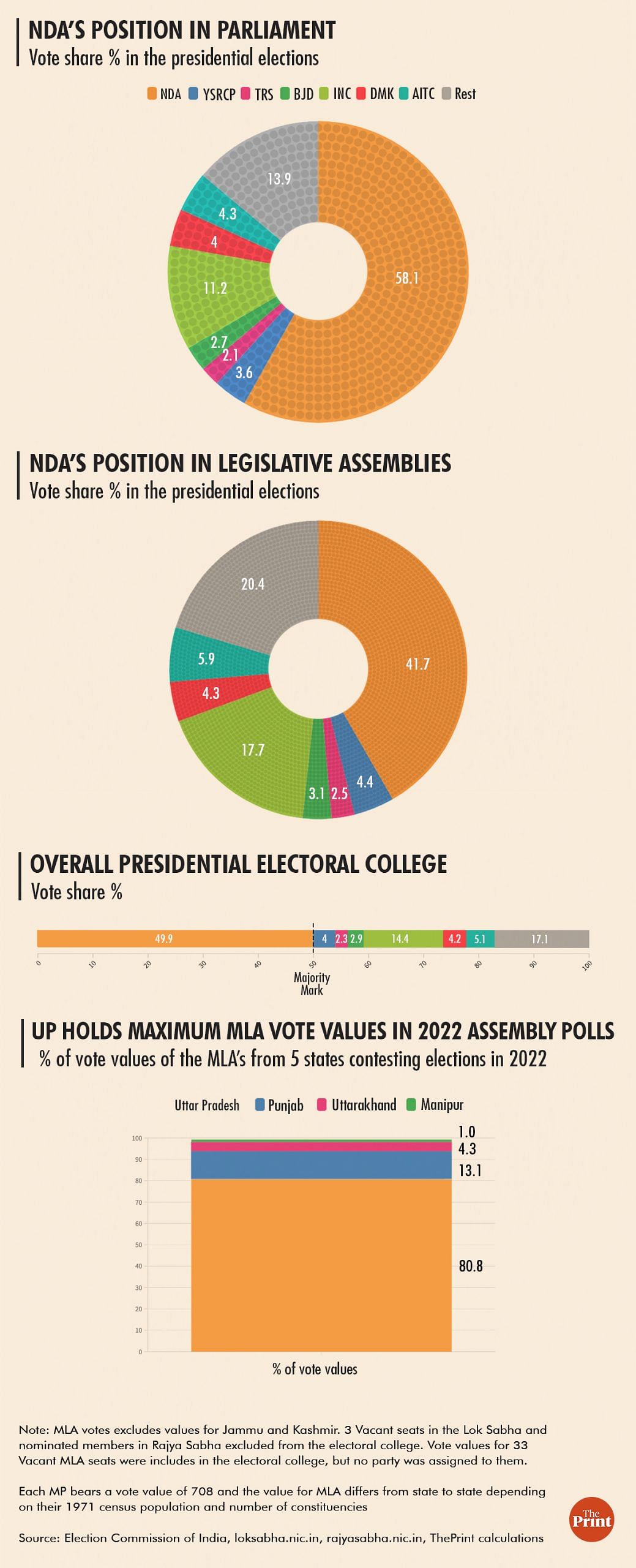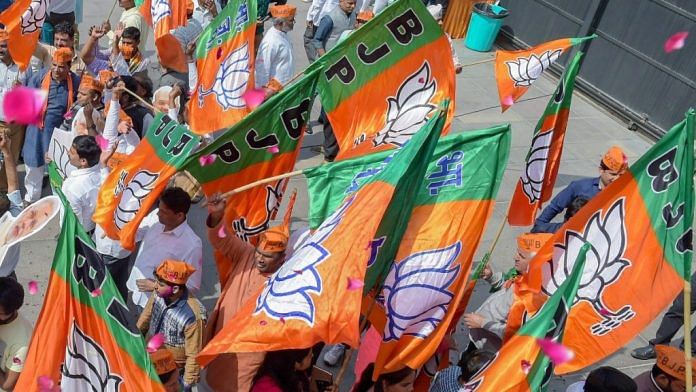New Delhi: There is more at stake for the BJP, apart from reputation and retaining power, in the 2022 Uttar Pradesh assembly elections.
The reason: the party needs to improve on its 2017 UP assembly poll performance — 312 out of 403 seats — if it has to sail through in the next presidential polls.
The term of India’s current President Ram Nath Kovind ends in 2022 and elections for the post will be conducted after assembly polls in five states — Uttar Pradesh, Uttarakhand, Punjab, Manipur, and Goa.
Since Presidential elections take into account the votes of both MPs and MLAs, every legislative seat the BJP wins in these assembly elections will be crucial, especially given it has lost a number of allies over the past couple of years.
While the BJP-led National Democratic Alliance (NDA) can get fence-sitters such as KCR’s Telangana Rashtra Samithi and Naveen Patnaik’s Biju Janata Dal (BJD) to back its Presidential candidate, it can do away with this necessity if it pulls off another landslide in UP.
Since 2018, several regional parties have broken ties with the NDA — the Telugu Desam Party (TDP) in Andhra Pradesh, the Shiv Sena in Maharashtra, and the Shiromani Akali Dal (SAD) in Punjab.
Factoring all the political movements since 2017, ThePrint has found that NDA’s vote share in the presidential election has fallen below the majority mark. As a result, any further dent in the current seat distribution is likely to increase the gap.
Also read: Why Priyanka Gandhi is meeting SP workers, & what it could mean for Congress ahead of 2022 polls
The Presidential election
The electoral college in the Presidential election comprises MLAs and MPs.
Each MP, irrespective of Lok Sabha or Rajya Sabha, carries a vote value of 708, which is based on a pre-decided formula.
The vote value for each MLA varies: it depends on the state’s population (1971 census) and its number of assembly seats.
This is where UP is vital — each of its MLAs carries a value of 208, the highest, as opposed to a mere 7 for an MLA in Sikkim.
For the NDA, its strength is in the Lok Sabha, where it has a clear majority with 334 of the 530 MPs. In the Rajya Sabha, of the present strength of 232, the NDA has 116 seats. The BJP enjoys a majority in the Rajya Sabha on the basis of 3 nominated candidates as of now, but they are not eligible for the Presidential polls.
And in states across the country, the NDA holds 1,761 of the 4,033 assembly seats. But it doesn’t hold key states where MLAs have a high vote value. For instance, an MLA in Tamil Nadu has a value of 176, in West Bengal, the figure is 151, it’s 176 in Jharkhand (based on the pre-decided formula), and 175 in Maharashtra.
In all at present strength, the NDA holds 49.95 per cent of the Presidential electoral college votes, 0.05 per cent votes below the majority mark.

Why UP and next year’s elections are crucial
The five states headed for assembly elections next year account for 1,03,756 votes, or approximately 10 per cent of the total electorate in the Presidential election.
Of this, nearly 80 per cent or 83,824 vote value is in Uttar Pradesh.
Barring Punjab, the NDA is already in power in four of the states. But in Goa, Manipur, and Uttarakhand, the vote value is 20, 18, and 64 respectively. These are also smaller states — Goa has only 40 MLAs. Manipur (60) and Uttarakhand (70)
Punjab’s 117 MLAs have a vote value of 116 each but given the breakup with SAD and the unrest due to the farmers’ protests, the NDA’s prospects are bleak in the state.
That leaves Uttar Pradesh, where at present, the NDA has 306 BJP MLAs and 11 from the Apna Dal — or 78 per cent of the total seats in UP.
But at the MLA vote value of 208, every 10 seats lost in the state means 0.02 per cent loss in electoral votes.
Any adverse result here could provide the opposition with much-needed motivation to mount a proper challenge in the elections.
There could be other repercussions, according to Rahul Verma, political scientist and fellow at the Centre for Policy Research.
“The outcome of the Uttar Pradesh results will define the bargaining power of the allies. A record victory in a state like UP will change the perceived balance of power,” Verma said. “So if the BJP wins by a huge margin, chances are that even some fence-sitters may also openly show support for the BJP’s choice of a presidential candidate”.
But losing the state even by a low margin will embolden even the BJP’s allies, Verma added.
“A loss of the BJP in Uttar Pradesh is not only going to dent the fence-sitters’ perception about the winnability of the party’s candidate, but it may also weaken the BJPs ties with its existing allies,” Verma said. “A loss in UP will increase the bargaining power of the allies, who would like to support the NDA only when a candidate of their choice is contesting. Remember the JD(U)-RJD breakup in Bihar happened after the BJP’s massive victory in the 2017 UP polls.”
Phone a friend?
Where the BJP is on safe ground is with fence-sitters like the BJD and Jagan Mohan Reddy’s YSR Congress Party, who have largely voted along with it in Parliament.
The YSR Congress Party holds 150 assembly seats in Andhra Pradesh worth 26,250 votes in the Presidential elections. It also has 28 MPs, in both the Rajya Sabha and Lok Sabha, worth 19,824 votes.
In the 2017 presidential elections, when it had fewer MLAs while being in opposition, the YSR Congress had supported the NDA candidate Ram Nath Kovind.
In neighbouring Telangana, the K. Chandrasekar Rao-led Telangana Rashtra Samithi, another fence-sitter, has 103 MLAs worth 13,596 votes. The TRS has 16 MPs worth 11,328 votes. The party too had supported the NDA candidate in the previous elections.
Likewise, the Naveen Patnaik-led Biju Janata Dal accounts for 16,837 votes from its MLAs and 14,868 votes from its 21 MPs. The BJD is another party that had backed the NDA in the last elections.
Clubbed together, these fence-sitters can help the NDA with an additional 9-10 per cent of the votes, which would give it a comfortable majority.
The numbers, however, come amid the opposition starting to show some signs of unity. Various party chiefs recently met election strategist Prashant Kishor, with the buzz being that the meeting was being held to unite the opposition for the Presidential polls next year. NCP leader Sharad Pawar has categorically denied it.
However, according to psephologist and founder of polling agency C Voter, Yashwant Deshmukh, the NDA will sail through even if it loses 100 seats in Uttar Pradesh in the worst possible scenario because of the fence-sitters.
“But the game might change if Sharad Pawar is fielded by the opposition. Due to the reservations put forth by the RSS, NDA can never give the Presidential position to Pawar,” Deshmukh said. “As a result, if he manages to combine the entire opposition, the support base may shift. In case that happens, every single seat in Uttar Pradesh will matter.”
Methodological note:
The electoral college for the Presidential elections in India is represented by two groups of leaders — Members of the Parliament (Lok Sabha+Rajya Sabha) and state MLAs. Each Parliamentarian has a vote value of 708 and the vote value of an MLA varies from state to state depending on their 1971 census population. With no clarity on Jammu-Kashmir elections, we have kept its assembly out of our analysis.
There were also 33 MLA seats lying vacant. We have included them in the electoral college but did not assign them to a party. There are also 33 MPs from the Rajya Sabha that are retiring before the Presidential elections. Considering the current strength of MLAs captures all their respective seats, the net loss/gain to NDA is 0.
This leads us to a total vote value of 10,87,683, of which the NDA has 5,43,062 votes (or 49.95%), almost 0.05% short of the majority.
(Edited by Arun Prashanth)
Also read: UP 2022 in focus, Bhim Army’s Aazad is cycling across state to ‘unite exploited’, expand base



